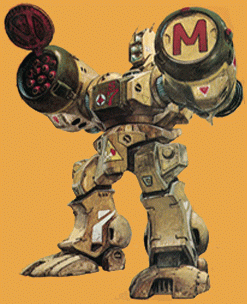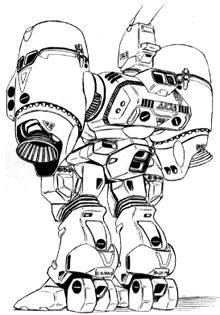 by Peter Walker and Pieter Thomassen, with Robert Morgenstern
by Peter Walker and Pieter Thomassen, with Robert Morgenstern
| | | | | |
Space Defense Robot SDR-04 Phalanx.
|

|

|

|

|
 |
 |  |  |  |  |  |
I. Dimensions:
| Total Height: | 12.7m |
| Height: | 11.3m (ground to searchlight) |
| Total Depth: | 5.0m |
| Total Breadth: | 7.5m |
| Weight: | 22.2 metric tons (dry) |
| | 47.2 metric tons (fully loaded). |
II. Type:
- One/two man all-weather heavy missile Destroid mecha.
III. Service History:
- Mark XII: Served with the RDF Spacy from late 2009, and
with the RDF Army from 2011, until 2020.
- Mark XIII: Served with the RDF Army and Southern Cross'
Tactical Corps from 2014 until 2020.
- Mark XIV: Served with the REF Army and Marines from 2019.
IV. Propulsion:
Generator:
- One Tirolian mecha protoculture-generator (known on Earth as the RT/PS-2a), providing
electrical power to the mecha; output classified.
Reserve Generator:
- CT 03 hydrogen/oxygen fuel cell, 970 kW for twelve hours.
Thrusters for Space Maneuvering:
(main)
- 2 x AST-04 dual thruster banks on the back, total thrust 14 kN with a total delta-v of
approximately 0.2 kps.
(vernier)
- 14 x Nakajima NBS-1 high-thrust vernier thrusters, located on the heels (4), calves (2),
forward waist (2), chest (2). The remainder are located on the missile pods (2) and on the back
(2).
V. Performance:
- Maximum speed: 72 kph with full missile load, 125 kph when unloaded.
- Generator endurance : 12 years operational use.
VI. Electronics:
Radar System:
- Hughes APG-198 short range (45 km) X band pulse Doppler phased array UWB radar.
Optical tracking:
- Thomson DOS-2000 multi-band digital camera system, for medium range spherical UV,
infra-red imaging and optical band detection and tracking
- Thomson LT-3 multi-frequency laser ranger and designator.
- Zeiss TS-2 long range telescopic array for visible/IR spectrum.
- Texcorp DARDA-3C electronic three-mirror positionable laser searchlight.
Tactical Electronic Warfare System (TEWS):
- Elettronica Radar Warning Receiver (RWR)
- OlDelft Infra-red Warning Receiver (IRWR)
- Westinghouse ALQ-198(V) active radar jammer
- Chaff dispenser
- Active missile jammers.
VII. Armament:
- 2 x Shin-Shim-10 drum-mount missile
launchers. The primary armament of this
mecha is made up of two large, arm-mounted missile bins. Each bin
contains 11 ready to fire and 11 reloads for a total per bin of 22 high-explosive, long range (70 km) Mach 3.0 combined multi-spectrum imager and active radar homing Derringer missiles (A variant).
The 130km range E and F variants of this missile can also be carried, but because of the missile's additional length, the reloads are sacrificed, and only 11 missiles per bin can be carried.
(Additional on SDR-04 mk XIII & mk XIV):
- 2 x Heckler & Koch GK-242 7.62mm
miniguns in the head, firing at the rate
of 6000 rounds per minute, storage capacity 3000 rounds each. Guns are
targetable, with an automated gun traverse. Mainly used in an anti-
personnel capacity.
(Additional on SDR-04 mk XIV):
- 1 x Mauser RöV-10 twin laser
turret, contains 2 light lasers. 360 degree rotation with 150 degree elevation/depression, firing 6 MJ laser pulses up to 60 times/minute. Weapon replaces the searchlight on earlier models.

VIII. Armor:
The armor on the Phalanx is composed of a standard Chobham laminar developed
in the late 20th century and improved with the materials science advances made
during the Robotech era. This armor was mainly designed to defeat projectiles
and other kinetic weapons. The armor stops all small arms and heavy infantry
weapons fire, provides excellent resistance to light mecha-mounted
weaponry, such as the Zentraedi 22.3mm HE autocannon round, and fair
resistance to medium mecha-mounted weaponry, such as the Valkyrie's 55mm
APFSDS round.
The Phalanx provides full protection from nuclear, biological, and chemical
hazards, using an overpressure cockpit environment activated by radiation and
hazardous chemical sensors, or manually when biological warfare conditions
are anticipated. The internal consumables supplies can provide atmosphere
for three days maximum.
IX. Development:
The SDR-04 Phalanx missile launch battery is part of the main Destroid series
used during the First Robotech War. This Destroid was designed to provide
more mobility to the tactical missile launchers previously in use on Earth.
This Destroid uses the same leg assembly as the MBR-04 Tomahawk
heavy infantry mecha and ADR-04 Defender air defense
mecha.
A missile-launching mecha was needed because of the vulnerability
of fixed missile batteries. Therefore, the Phalanx torso was designed.
It consisted out of nothing more than a missile-launch station and pilot
seat, data-link equipment and two very large missile pods. These missile
pods could carry 22 of the largest mecha-mounted each, which gave one
Phalanx firepower comparable to the refitted Iowa-class battleships in
service with the 1980s US Navy. The Phalanx usually fired its long range
missiles from a position 20-100km away from the fighting, because this mecha
had very little in the way of secondary armament and really only minimal
armor. It could fire its missiles on a direct trajectory, but this would
degrade its stand-off capabilities by using large LR missiles for what was
essentially SR work. The Phalanx was developed on the SDF-1 in late 2009,
and did not see service on Earth until after the Zentraedi holocaust. A
variant, the Mark XIII, saw service with the RDF Army, and incorporated
a pair of miniguns for emergency anti-personnel use.
The Destroids based on this undercarriage were among the most important
mecha during the First Robotech War and the later Malcontent Uprisings
through 2019, and the Mark XIV also saw action with the REF against the Invid,
although this versions was refitted with more powerful weapon systems, and
newer armor plating which gave more protection.
Addendum, REF upgrade:
(Phalanx mk XIV)
The armor was replaced with a thicker layer of low-mass Chobham, increasing the protection to levels similar to that on the Veritech Hover Tank at no cost in additional weight. Naturally, the electronics were all updated as well. The electronics upgrades are as follows:
Radar Tracking:
- Westinghouse APG-307 medium range (up to 50 km) UWB phased array spherical
pulse-Doppler, for detection and tracking of targets, with battlefield surveillance modes.
Optical Tracking:
- Phillips AllView multi-band digital camera system, for medium range all-altitude infra-red
imaging, optical and ultra-violet band detection and tracking
- Thomson LT-5 multi-frequency laser ranger and designator.
Tactical Electronic Warfare System (TEWS):
- Elettronica Radar Warning Receiver (RWR)
- Oldeft Infra-red Warning Receiver (IRWR)
- Westinghouse ALQ-250(V) active sensor jammer
- Chaff dispenser
- Flares.
See additional design notes.
Return to UNDF Index
Go to Robotech Reference Guide Home Page.
Robotech (R) is the property of Harmony Gold. This document is in no
way intended to infringe upon their rights.
Content by Peter Walker and Pieter Thomassen, with Rob Morgenstern
HTML by Robert Morgenstern
rmorgens@ieee.org
Copyright © 1997, 1995 Robert Morgenstern, Peter Walker, Pieter Thomassen
Last Updated: Monday, November 17, 1997 2:02 PM






